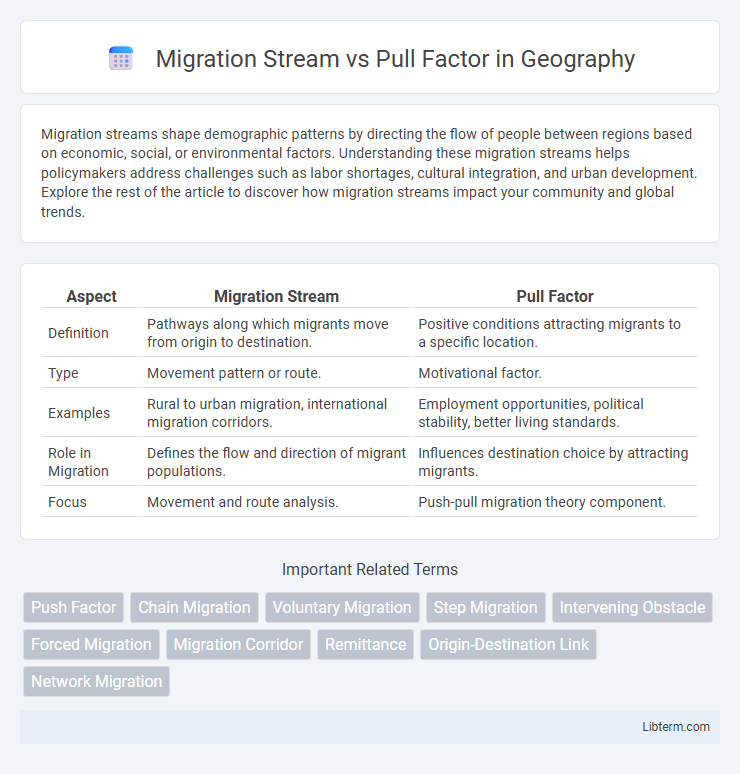Migration streams shape demographic patterns by directing the flow of people between regions based on economic, social, or environmental factors. Understanding these migration streams helps policymakers address challenges such as labor shortages, cultural integration, and urban development. Explore the rest of the article to discover how migration streams impact your community and global trends.
Table of Comparison
| Aspect | Migration Stream | Pull Factor |
|---|---|---|
| Definition | Pathways along which migrants move from origin to destination. | Positive conditions attracting migrants to a specific location. |
| Type | Movement pattern or route. | Motivational factor. |
| Examples | Rural to urban migration, international migration corridors. | Employment opportunities, political stability, better living standards. |
| Role in Migration | Defines the flow and direction of migrant populations. | Influences destination choice by attracting migrants. |
| Focus | Movement and route analysis. | Push-pull migration theory component. |
Introduction to Migration Stream and Pull Factor
Migration streams refer to the regular, predictable patterns of people moving from one region or country to another, often influenced by economic, social, or political conditions. Pull factors are the attributes or conditions of a destination that attract migrants, such as employment opportunities, higher living standards, or political stability. Understanding the interaction between migration streams and pull factors is essential for analyzing migration trends and policy impacts.
Defining Migration Stream: Key Concepts
Migration stream refers to the continuous flow of migrants moving between a specific origin and destination over time, shaped by various push and pull factors. Defining migration stream involves analyzing migration patterns, routes, demographic characteristics, and socioeconomic influences impacting migrant decisions. Understanding key concepts like origin-destination pairs and temporal consistency helps distinguish migration streams from isolated migration events.
Understanding Pull Factors in Migration
Pull factors in migration are the positive attributes of a destination that attract individuals, such as better employment opportunities, higher living standards, and political stability. These factors significantly influence migration streams by creating a consistent flow of migrants toward regions offering improved economic prospects, education, and safety. Understanding pull factors helps policymakers design targeted strategies to manage migration more effectively and support integration efforts.
Differences Between Migration Streams and Pull Factors
Migration streams refer to the actual routes and patterns through which groups of migrants move from one geographic location to another, often influenced by social networks and established pathways. Pull factors are the specific attractions, such as economic opportunities, political stability, or better living conditions, that draw migrants toward a particular destination. The key difference lies in migration streams describing the movement process and pathways, while pull factors represent the reasons or incentives encouraging that movement.
Historical Examples of Migration Streams
Migration streams illustrate the organized movement of populations over time, such as the Great Migration in the United States between 1916 and 1970, where millions of African Americans relocated from the rural South to urban Northern cities driven by industrial job opportunities. Pull factors like economic prospects, political stability, and social freedom often attract migrants, exemplified by the influx of European immigrants to the United States in the late 19th and early 20th centuries seeking better livelihoods. Historical migration streams highlight how pull factors shape demographic changes by creating concentrated flows of people responding to favorable conditions in destination regions.
Common Pull Factors Influencing Migration
Common pull factors influencing migration include economic opportunities, such as availability of jobs and higher wages, which attract individuals seeking improved living standards. Social factors like better education, healthcare facilities, and political stability also serve as significant pull factors. Environmental attributes like favorable climate and safer living conditions contribute to the migration stream by drawing people toward more desirable regions.
Relationship Between Migration Streams and Pull Factors
Migration streams are significantly influenced by pull factors, which are the favorable conditions in a destination area attracting migrants. Economic opportunities, political stability, and better living standards act as strong pull factors that shape and sustain migration streams by drawing populations from origin regions. The intensity and direction of migration flows are thus closely linked to the strength and appeal of these pull factors.
Socioeconomic Impacts of Migration Streams
Migration streams driven by socioeconomic pull factors such as better employment opportunities, higher wages, and improved living standards significantly reshape urban labor markets and local economies. These inflows increase demand for housing, education, and healthcare services, often leading to both economic growth and infrastructure strain in destination regions. The redistribution of human capital also alters social dynamics, potentially reducing regional inequalities while creating challenges in social integration and resource allocation.
Policy Implications: Managing Pull Factors
Managing pull factors in migration requires targeted policy interventions that address economic opportunities, social services, and safety perceptions in destination regions. Policies focusing on improving border controls, regulating labor markets, and enhancing local infrastructure can mitigate uncontrolled influxes driven by pull factors. Coordinated international efforts promote balanced migration flows while supporting sustainable development in both origin and destination areas.
Future Trends in Migration Streams and Pull Factors
Future trends in migration streams are increasingly influenced by evolving pull factors such as economic opportunities, climate change adaptation, and technological advancements. Urbanization and shifts in global labor markets create strong pull factors that redirect migration patterns toward emerging megacities and technologically advanced regions. Policy changes, environmental stressors, and digital connectivity will continue to shape complex interactions between migration streams and pull factors, driving more dynamic and multi-dimensional migration flows worldwide.
Migration Stream Infographic

 libterm.com
libterm.com